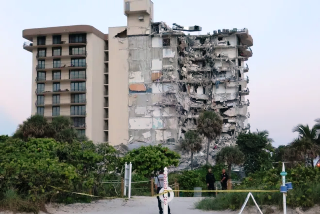|
The deadly June 2021 collapse of the Champlain Towers South condominium in Surfside has raised awareness about the need for stricter building and inspection standards across Florida. |
Many common defects in Florida condominiums stem from poor waterproofing, which protects buildings from the Florida rain. Other water-related defects that can be found in high-rise condominiums and other structures include:
-
Water intrusion through windows and sliding glass doors.
-
Improper waterproofing of balconies.
-
Leaks from elevated resort-style pool decks.
These defects
drastically decrease the life expectancy of the buildings
and reduce the value of the investments made by residents.
They may also cause structural problems that result in
costly repairs.
A new condominium project looks beautiful – but what lies
beneath should be the concern and focus of all associations.
The turnover of control of a condominium from the developer
to the owners is not merely a passing of a board position.
It also entails the transfer of great responsibilities to
the board members, who have fiduciary and statutory duties
to the owners to maintain the common elements of the
association.
The board members take on the responsibility of maintaining
complex systems, which they typically have not seen and
require significant capital to sustain or, even worse,
replace. Though some symptoms of construction defects may be
apparent – water intrusion, mold, cracking stucco – others
may not manifest themselves for years, at which time it is
too late for the association to seek recovery from the
liable parties.
It is vital for boards to work with appropriate
professionals to investigate the condition of the building
components and ensure that condominium developers have
delivered their buildings in good condition – free of
defects, deficiencies and code violations.
Typically, the best team to assemble is a construction
defect law firm that can direct you to the proper experts to
perform a building investigation. Ideally, this means
bringing in a forensic engineer who can walk through and
extensively review the site – all while keeping a trained
eye on the building components to identify anything that may
require further investigation.
If any issues are found, the next step calls for the
forensic engineer to direct an invasive investigation of the
building. Through this process, the engineer can investigate
the construction of the building at various locations in a
"peel the onion" fashion to see how each trade performed its
work and identify any defective construction.
It is imperative that boards do not try to take on this task
alone. And it is also imperative that they don't delay in
addressing potential construction defects that have been
identified – it is a critical step in protecting both the
boards and the owners they represent.
